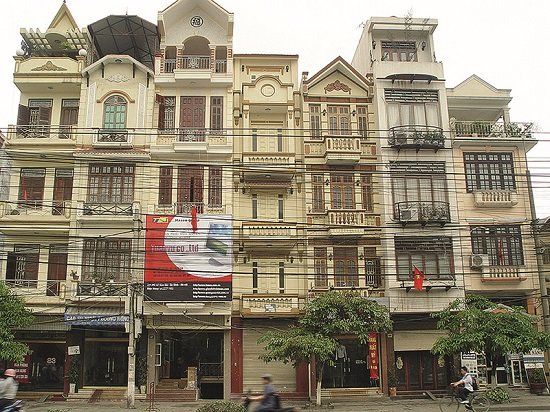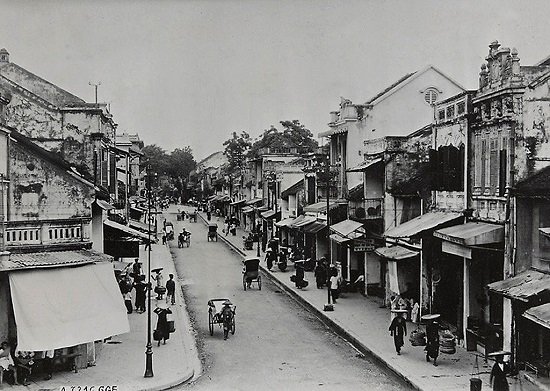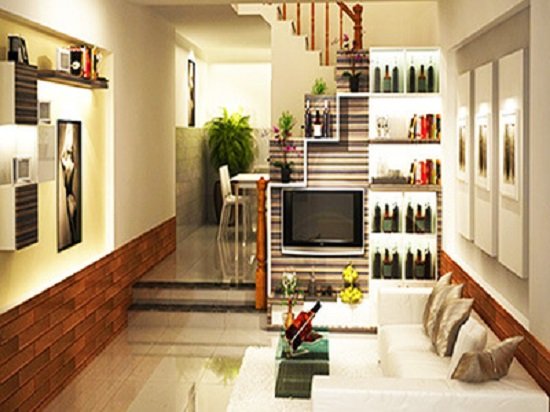Each country has its own architectural beauty with temples and buildings, but the houses will certainly be of great interest to anyone travelling to a new culture as they perfectly reflect the local way of life. Vietnam is an excellent example, my traditional and characteristic house is tube-shaped. Let’s discover in this article this type of architecture and find an answer to this interesting question:
“Why are Vietnamese houses long and narrow?”
What is a tube house?
If you spend some time walking around Ho Chi Minh City, Hanoi or any other city in Vietnam you will definitely notice these houses. It will be very easy for you to understand what tube houses are in Vietnam. It is a house with a narrow facade that rises to the top. Each house is attached to the other, as shown in the photo below, and here there are no less than seven houses attached to each other.

Tube houses nowadays are seen with 1, 2, 3, and 4 floors stacked, and that’s why you can find in the streets such high houses standing side by side. Vietnamese tube houses that are built with traditional structures are now particularly popular in Vietnamese cities.
How was the tube house born?
When you travel around Hanoi, Ho Chi Minh City or other cities, you have to ask yourself why the Vietnamese apply this architecture to the design of their houses. To understand this, we have to go back to the time of French colonialism in Vietnam, rumour has it that housing taxes were calculated according to the area of the facade.
So shrinking the facade turned out to be a good solution to reduce taxes, which explains this type of traditional architecture. However, Vietnamese tube houses are still used today because of the practical needs of people.

In the modern era, when cities are very dense and land prices are continuously increasing, finding enough space for a large number of people is really important. Therefore, crammed floors of tube houses can be a preferred option to provide rooms for many people.
In general, these houses do not have gardens, many households grow vegetables, and flowers on the terrace, and the houses are side by side without any noticeable separation.
One floor for each generation
As you may know, Vietnamese people often share their homes with several generations. This typical Vietnamese culture of living together has many advantages. People are happy to be together and help each other, and grandparents take care of their grandchildren. And the adult children take care of their elders.
However, this situation does not have only advantages, indeed promiscuity can also lead to some nervous breakdowns!
The Vietnamese tube house is therefore designed to alleviate this kind of unpleasantness. Inside, the tube houses are clearly divided into separate floors, each with a bathroom and a bedroom. This design guarantees privacy while allowing the family to be united. Often each floor is used by a generation. The older generation will be downstairs, so that they do not have to climb the stairs.
The kitchen, ancestor’s altar, and tea room are shared, often on the ground floor.
Typical tube house architecture
The characteristics of Vietnamese tube houses represent Vietnamese insight and flexibility, and their ingenuity in making good use of the earth’s resources. Although the structure of tube houses is not something so extraordinary, what makes them special is that they become typical architecture that has existed since ancient times, reflecting the Vietnamese way of life until now.
A typical tube house design is 2.5 m to 5 m wide, the length which you can also consider as the depth of the house is 5 to 8 times larger than the width. The area of a normal tube house is often about 25 square metres. A closer look at the interior structure reveals that the floors are meant for different spaces, so if people want more, they can stack more floors. The ground floor can be for a garage, a rented office or a living room but there is always space for family members. In the middle of the house is an air shaft ventilating the rooms, which you can easily see by looking at the design of the house.

In addition, Vietnamese tube houses can now have a tile or concrete roof. The Vietnamese also use the flat concrete roof to create a small terraced garden for vegetables or flowers. And to create more space and chic design inside the house, mezzanines are also applied. Mezzanines are like intermediate floors that are inserted into floors with high ceilings. The Vietnamese also take stairs into consideration when building their tube houses. Not only are stairs considered the backbone of the house, but they also play a crucial role in ensuring the safety of families, especially those with children. Due to the small space, the stairs in tube houses usually have many turns.
In Vietnamese superstitions, stairs are also arranged according to Feng Shui as they are believed to be bridges leading spiritual air up and down. There should be no space between the steps as they can endanger children and disperse good air. Also, in Feng Shui, the number of stages is important to create a good structure for the house as each stage is thought to parallel each stage of the life cycle “Birth, Aging, Illness and Death”. Stairs would be better to stop at the “Birth” stage, and it is better to avoid being in “Death” in the last stage which can affect family members spiritually.
Trade and commerce
Moreover, the Vietnamese know perfectly well how to use tube houses for commercial purposes. It is very frequent that a part of the ground floor is used to improvise a small business: Grocery shop, Café, Restaurant, hardware store, shoemaker, everything is possible!
The Vietnamese tube house is a perfect example of pragmatism!
Conclusion
The tube houses in Vietnam have been transformed to help people adapt to modern times, but it is undeniable that they have not kept all the old versions. Nevertheless, the exceptional architecture has inherited the typical structure of the houses in the past. And the architecture of the housing can be considered as a pride of Vietnamese people because they reflect well the way of life of the people and the Vietnamese culture. Anyone who loves culture and architecture should take time to discover these beautiful things of the tube houses just to see how special they are and admire the intelligent design they have.



